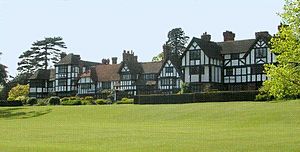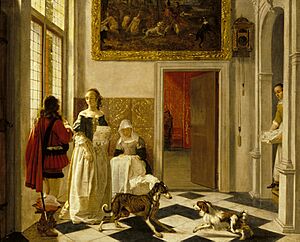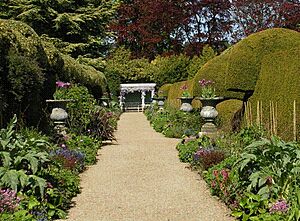Ascott House facts for kids
Quick facts for kids Ascott House |
|
|---|---|

The centre of the entrance front, the oldest part of the house. A beam over the present front door (behind the fountain) gives the date 1606
|
|
| General information | |
| Status | Complete |
| Type | Country house |
| Location | Ascott, Buckinghamshire, England |
| Coordinates | 51°53′44″N 0°42′22″W / 51.89545°N 0.70617°W |
Ascott House, also called Ascott, is a beautiful old country house in Buckinghamshire, England. It's a very special building, listed as Grade II*, which means it's important for its history and architecture. The house sits on a large piece of land, about 32 acres (13 hectares).
Ascott House started out as a farmhouse way back in the 1600s, during the time of King James I. It was known as "Ascott Hall" then. In 1873, a rich man named Baron Mayer Amschel de Rothschild bought it. His family, the Rothschild family, had already bought a lot of land in Buckinghamshire. They built many big houses there starting in the 1850s.
Baron Mayer gave Ascott House to his nephew, Leopold de Rothschild. Over the next few decades, Leopold changed the farmhouse into the large, comfortable country house you see today.
Contents
The House's Design
When Leopold de Rothschild first owned Ascott, he used it as a place to stay when he went hunting. His main home was Gunnersbury Park. He soon realized Ascott was too small. So, in 1874, he hired an architect named George Devey to make it bigger.
The house you see now, with its half-timbered look, is mostly thanks to Devey's work. He wanted the house to look like it had grown slowly over hundreds of years. It was a project that lasted for much of Devey's life, as the house kept getting bigger through the late 1800s.
A Unique Style
The house's style mixes "English cottage" with "Tudor" manor house looks. It's very relaxed and informal. The bottom floor is made of red brick, and the upper floors have wooden beams with plaster in between. This country style showed that Ascott was meant to be a quiet place for fun and relaxation.
It was different from other Rothschild homes in the area, which were often grander. For example, Mentmore Towers was built in a classical style, and Waddesdon Manor looked like a French castle. Ascott's design wasn't trying to copy an old style exactly. Devey was a pioneer of the Arts and Crafts movement, and he created his own rustic look.
The house has huge bay windows that offer amazing views of the Chiltern Hills. Its many gables, with roofs at different heights, look similar to designs by the famous architect Edwin Lutyens.
Inside Ascott House
After Mrs. Leopold de Rothschild passed away in 1937, her son, Anthony Gustav de Rothschild, inherited the house. He and his wife, Yvonne D'Anvers, made the house even bigger. They also decorated the inside, filling it with famous paintings and a large collection of English furniture from the 1700s. This was special because most Rothschild houses focused on other types of art.
The main rooms on the ground floor are large and beautiful. Even though they are filled with amazing art and furniture, they have lower ceilings. This keeps the informal, comfortable feeling of the house.
Art and Collections
The entrance hall is famous for its big paintings by artists like Thomas Gainsborough, George Romney, and Joshua Reynolds. There's also a large painting by George Stubbs called Five Mares.
The dining room looks like it has Dutch tiles, but it's actually a clever painting trick called trompe-l'œil. This room has many small Dutch paintings from the 1500s and 1600s by artists such as Aelbert Cuyp and Jan Steen.
In the common room, you can see a portrait of a religious leader thought to be by Lorenzo Lotto. The Drawing Room displays a collection of blue Chinese ceramics. These pieces range from the ancient Han dynasty (around 206 BC) to the Qing dynasty (which ended in 1911). This room also has a painting called Madonna and Child with St. John by Andrea del Sarto, painted in 1520.
In 1936, the Billiards Room was changed into a library. It holds many books collected by Anthony de Rothschild. This is one of the coziest rooms in the house. Its walls are lined with books, broken up by Gainsborough's full-length portrait of the Duchess of Richmond and other masterpieces. You can also see Tiepolo's "The Assumption of the Virgin" here. The room also has furniture by Thomas Chippendale and old Chinese ceramics.
Beautiful Gardens
The large, well-kept gardens were designed with advice from Sir Harry Veitch around 1902. Leopold de Rothschild created them as a wedding gift for his wife. There's a sundial made entirely of trimmed bushes, with Latin numbers. It says in clipped yew: "Light and shade by turn, but love always."
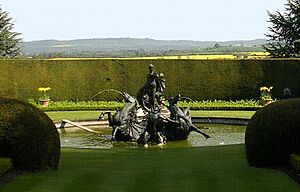
Close to the south side of the house are paved garden areas, similar to those designed by Gertrude Jekyll. Beyond these, across wide lawns, are the terraced gardens. These gardens are known for their trimmed hedges, shaped bushes (topiary), and flowering shrubs.
The biggest feature in the garden is a bronze fountain. It shows Venus in her shell chariot with cherubs. This fountain was made by the American sculptor Thomas Waldo Story. Story also made the fountain in the Dutch flower garden. This garden is famous for its tulips in spring. You reach it by going down steps through a rock garden with a dripping grotto and fake stalagmites. In the center of this garden, Story's tall fountain, topped with Cupid and dolphins, is surrounded by formal flower beds.
From the garden near the main entrance, which has trimmed box and bay trees, a long grassy path leads to the lily pool. This path is surrounded by a tall beech hedge. The lily pool was first made for skating. It is now the center of a garden inspired by Monet's gardens, and it has a thatched summerhouse designed by George Devey.
Cricket at Ascott
Cricket was first played at Ascott House on August 28, 1880. A team from London played against a team chosen by a Mr. Tennant. Leopold de Rothschild was there for this first game. The Rothschild family played a big part in starting the Buckinghamshire County Cricket Club.
Buckinghamshire first played at Ascott House in 1905. They played there regularly once a season until 1979. The county team returned to Ascott in 1998 for a cup match. Minor Counties Championship cricket was last played there in 2003. Buckinghamshire's last game at the ground was in 2009.
The ground hosted one professional cricket match in 2003. A top-level team, Gloucestershire, visited. Gloucestershire scored a huge 401 runs, then bowled Buckinghamshire out for only 77 runs, winning by 324 runs.
Ascott Today
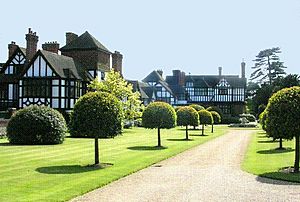
In 1947, Anthony de Rothschild gave Ascott House, along with some of its important art and a small part of the land, to the National Trust. The National Trust calls the property "Ascott." However, just like at nearby Waddesdon Manor, the Rothschild family still has a very close connection to the house.
The last person to live in the house was Sir Evelyn de Rothschild, Anthony's son, who passed away in 2022. He added more art and ceramics to the collection. Much of what you see in the house today is still privately owned by the Rothschild family.
Sir Evelyn de Rothschild also made the estate much larger, to about 3200 acres (13 square kilometers). The estate now has many miles of new trees planted along roads, well-kept hedges, and new woodlands. A major new road, the A505, goes through the area between the house and its Stud Farm, but it has been hidden by thick tree planting.
Ascott House still feels very much like a private home. It is open to the public on many weekday afternoons during the summer.
See also
- Rothschild properties in England
- Rothschild family


